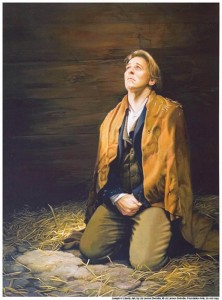In October of 1838, anti-Mormon mobs and militia laid siege to the Mormon settlement of Far West. After three days, the leaders of the Church were told that the leader of the militia would like to discuss a peace agreement, but instead he arrested the leaders.They were first taken to Independence and put on public display, then were detained in Richmond for two weeks while a trial was held. They were chained together and watched by guards in a vacant house. The trial was unfair. Witnesses against the leaders lied and exaggerated. The judge had decided before the trial that the men would be sent to jail, as recorded by Alexander Doniphan, “if a cohort of angels were to come down, and declare we were innocent, it would all be the same; for he [Austin A. King, the judge of the trial] had determined from the beginning to cast us into prison.”1 When Joseph Smith and the other prisoners turned in a list of defense witnesses, these witnesses were all jailed or driven out of the county. After the trial some of the men were released.While in Richmond, Joseph and the others who were imprisoned with him were treated terribly by the guards. Parley P. Pratt recorded that one night the guards were loudly using obscene language and making jokes about the horrible things they had done to the saints, when Joseph suddenly stood, still shackled, and said in a loud voice, “silence ye fiends of the infernal pit. In the name of Jesus Christ I rebuke you, and command you to be still; I will not live another minute and bear such language. Cease such talk, or you or I die this instant!”2 The guards lowered or dropped their weapons, asked pardon of Joseph Smith, and were quiet the rest of the night.On November 30, 1838, Joseph Smith, Hyrum Smith, Sydney Rigdon, Lyman Wight, Alexander McRae, and Caleb Baldwin were taken to Liberty Jail to await another trial. They had been charged with treason to the state of Missouri, an exaggerated and unjust charge. The spent their first day in the jail on December 1, 1838.Liberty jail was more like a dungeon. It was twenty-two feet square and had two levels, both below ground. A hole in the floor of the top level was the only way to get to the lower level. The only way out of the jail was through a trap door in the ceiling. The ceilings on both levels were so low that two of the men who were confined there were never able to stand up straight. There were “inner and outer walls which, combined, were four feet thick. Loose rocks were placed between the walls to thwart any attempt at burrowing through.”3 They were forced to stay in Liberty Jail for four months during a bitterly cold winter. There were narrow openings that provided the only light in the prison. Unfortunately these openings also let in the cold. Conditions were horrible. They were often fed rotten or poisoned food that would make them sick. Joseph Smith and the others not only suffered physically but were also constantly worried about the members of the Church who had been pushed from their homes in Missouri and were suffering in the swamps of Illinois.The time in Liberty Jail wasn’t completely bad. The jail has been nicknamed the “Temple Jail,” because Joseph Smith received so many important revelations and had time to reflect on gospel principles while in Liberty Jail. Joseph Smith received the revelations found in Doctrine and Covenants 121; 122, and 123; all of these revelations were received when Joseph pleaded for the suffering saints. Joseph also recorded that the suffering he experienced at Liberty Jail was beneficial, “For my part, I think I never could have felt as I now do if I had not suffered the wrongs that I have suffered. All things shall work together for good to them that love God.”4 In February, Sidney Rigdon was let free because he became very ill. The others remained in Liberty Jail. Finally, in April of 1839, the prisoners were taken out of Liberty Jail to be taken to Gallatin, Missouri, for a hearing. After the hearing, the men were then told that they would be taken to a jail in Boone County. A grand jury was brought together with a bill of charges for murder, treason, burglary, arson, larceny, theft and stealing. All of the charges were extreme exaggerations or outright lies. The men guarding the prisoners knew that they were not bad men and allowed them to escape. In February, Sidney Rigdon was let free because he became very ill. The others remained in Liberty Jail. Finally, in April of 1839, the prisoners were taken out of Liberty Jail to be taken to Gallatin, Missouri, for a hearing. After the hearing, the men were then told that they would be taken to a jail in Boone County. A grand jury was brought together with a bill of charges for murder, treason, burglary, arson, larceny, theft and stealing. All of the charges were extreme exaggerations or outright lies. The men guarding the prisoners knew that they were not bad men and allowed them to escape.
Over the years the jail was torn down, but the floor and some of the walls remained. In 1939 the Mormon Church purchased the jail, and in 1963 Joseph Fielding Smith dedicated the jail and authorized a partial reconstruction. This partial reconstruction is inside of a visitor’s center, and is open to the public for tours. There is also artwork and exhibits to see while visiting Liberty Jail. See the next article in the timeline series. Other Links: 1 History of the Church 3:213. |
